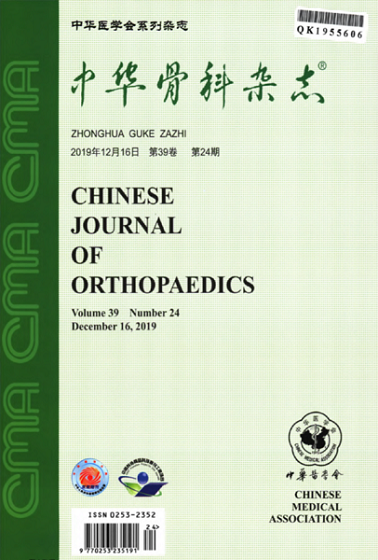Influence of patella position on soft tissue balance and clinical outcomes in patients undergoing total knee arthroplasty via a midvastus approach
Q4 Medicine
引用次数: 0
Abstract
Objective To compare the effects of patellar position on the balance of soft tissue during the operation and the postoperative outcomes in minimally invasive total knee arthroplasty via a midvastus approach. Methods From December 2018 to February 2019, a total of 55 patients were enrolled for primary total knee arthroplasty via a midvastus approach. All patients were randomly divided into 2 groups by random number table. During the operation, the gap balance technique was used with patella reduced or subluxated to complete the osteotomy and balance of soft tissue. The changes of gap and varus-valgus angle were compared between the patellar reduction group and the patellar subluxation group in both extension and flexion position. These data were also compared before and after reducing patellar in the patellar subluxation group. Furthermore, the differences of femoral prosthesis rotation, mechanical femoral axis to tibial axis angle, Knee Society score (KSS), visual analogue scale (VAS) and range of motion (ROM) were compared between the two groups. Results All patients finished 6 months follow-up, including 27 patients in the patellar reduction group and 28 patients in the patellar subluxation group. After osteotomy and soft tissue balance during the operation, there was no significant difference in gap and varus-valgus angle between two groups in either extension or flexion position. While in the patellar subluxation group, the flexion gap was 10.5±0.3 mm with patella subluxated, less than 11.0 ± 0.3 mm after reducing the patella. The varus-valgus angle was 1.5±0.3 with patella subluxated, less than 2.3±0.4 degree after reducing the patella. The difference was statistically significant (t=4.180, P 0.05). The rotation angle of the femoral component in the patellar subluxation group was -0.49°±1.2°, and the external rotation angle was smaller than that in the patellar reduction group (0.24°±1.3°). The difference was statistically significant (t=2.116, P=0.039). At one month after operation, ROM of the patellar reduction group was 109.6°±8.5° which was higher than that of the patellar subluxation group (104.9°±8.6°, t=2.048, P=0.046). There was no significant difference in ROM between the two groups at 3 and 6 months (P>0.05). Moreover, there was no significant difference in KSS and VAS at 1, 3 and 6 months after operation (P>0.05). Conclusion In the minimally invasive total knee arthroplasty, it is suggested to balance the soft tissue as much as possible with the patellar reduced. Otherwise, the consequence of increased flexion space, increased varus and increased internal rotation of femoral prosthesis should be considered. The patients undergoing soft tissue balance with patella reduced have better ROM in the early stage postoperatively. Key words: Arthroplasty, replacement, knee; Patella; Treatment outcome髌骨位置对经股中入路全膝关节置换术患者软组织平衡及临床结果的影响
目的比较微创股中入路全膝关节置换术中髌骨位置对软组织平衡的影响及术后效果。方法从2018年12月至2019年2月,共有55名患者通过股中部入路进行初次全膝关节置换术。采用随机数表将所有患者随机分为2组。术中采用间隙平衡技术,髌骨复位或半脱位,完成软组织截骨和平衡。比较髌骨复位组和髌骨半脱位组在伸屈位间隙和外翻内翻角的变化。还比较了髌骨半脱位组髌骨复位前后的这些数据。此外,还比较了两组股骨假体旋转、股骨轴与胫骨轴的机械角度、膝关节学会评分(KSS)、视觉模拟评分(VAS)和运动范围(ROM)的差异。结果所有患者均完成了6个月的随访,其中髌骨复位组27例,髌骨半脱位组28例。在截骨和手术过程中的软组织平衡后,两组在伸展或屈曲位置的间隙和外翻内翻角度没有显著差异。髌骨半脱位组髌骨半脱位时屈曲间隙为10.5±0.3mm,髌骨复位后屈曲间隙小于11.0±0.3mm。髌骨半脱位时外翻角度为1.5±0.3°,髌骨复位后外翻角度小于2.3±0.4°。差异有统计学意义(t=4.180,P 0.05)。髌骨半脱位组股骨组件旋转角度为-0.49°±1.2°,外旋角度小于髌骨复位组(0.24°±1.3°)。差异有统计学价值(t=2.116,P=0.039)。术后1个月,髌骨复位组ROM为109.6°±8.5°,高于髌骨半脱位组(104.9°±8.6°,t=2.048,P=0.046),3个月和6个月时两组ROM差异无统计学意义(P>0.05),结论在微创全膝关节置换术中,应尽量平衡软组织,减少髌骨损伤。否则,应考虑股骨假体屈曲间隙增加、内翻增加和内旋增加的后果。髌骨复位的软组织平衡患者术后早期ROM较好。关键词:关节成形术,置换术,膝关节;Patella;治疗结果
本文章由计算机程序翻译,如有差异,请以英文原文为准。
求助全文
约1分钟内获得全文
求助全文

 求助内容:
求助内容: 应助结果提醒方式:
应助结果提醒方式:


